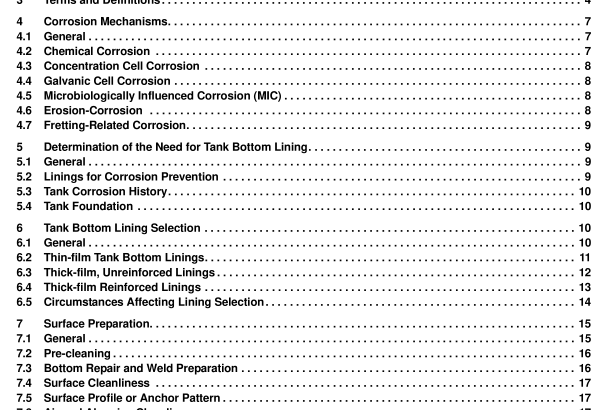API RP 652:2014 pdf free download.Linings of Aboveground Petroleum Storage Tank Bottoms
4.3 Concentration Cell Corrosion Concentration cell corrosion may occur when a surface deposit, mill scale, or crevice creates a localized area of lower oxygen concentration. The area under a surface deposit may be penetrated by a thin layer of electrolyte, which soon becomes depleted of oxygen. The difference in oxygen concentration between the inaccessible area and the bulk electrolyte creates a galvanic cell, with the contact area of the surface deposit being anodic to the surrounding tank plate. Concentration cell corrosion will cause pitting and may result in significant localized metal loss. Pitting of a bare steel tank bottom may occur at a rate as high as 80 mils (2.0 mm) per year.
4.4 Galvanic Cell Corrosion Hot-rolled carbon steel, typically used for the construction of petroleum storage tanks, is covered with a thin layer of oxide called mill scale, which is cathodic to the base steel. In the presence of a corrodent (such as dissolved oxygen) and an electrolyte, a galvanic corrosion couple forms at breaks in the mill scale. Accelerated pitting corrosion of the steel at breaks in the mill scale can result. Mill scale may be removed from both sides of the tank bottom plate by abrasive blast cleaning or by pickling, but removal of mill scale from the underside of the steel bottom is not commonly done. Removal of mill scale from the underside of new steel bottoms may be considered in an effort to promote a more uniform corrosion and minimize accelerated pitting corrosion that may occur. In some cases, welding can produce large differences in the microstructure of a steel bottom plate resulting in a built- in galvanic couple. In the presence of a corrodent and an electrolyte, preferential corrosion can occur at the heat- affected zones (HAZ) of the base metal near the welds. This type of corrosion can cause significant localized metal loss.
4.5 Microbiologically Influenced Corrosion (MIC) Bacteria [e.g. sulfate reducing bacteria (SRB) and acid producing bacteria (APB)] are widespread in the petroleum industry. The role of bacteria in corrosion is universally recognized but the mechanisms are not well understood. Generally, the effect of bacteria on the corrosion of bare steel tank bottoms is negligible. In some cases, however, severe corrosion has been attributed to MIC. The bacteria colonies form deposits on the steel that may provide an effective barrier to the diffusion of dissolved oxygen. Thus, the mere physical presence of bacterial deposits can promote aggressive pitting corrosion by the concentration cell mechanism described in 4.3.
The metabolism of bacteria is important with regard to the corrosion of storage tank bottoms. Most bacteria found in the petroleum industry are strict anaerobes that do not proliferate in the presence of oxygen; however, the dense bacterial colonies create a local anaerobic condition, even if some oxygen is available. By creating the local anaerobic condition, the bacteria can stay alive in the presence of oxygen, even though the colonies do not expand. In the case of SRB, colonies derive energy principally from the reduction of sulfates to sulfide, and this metabolic end product is corrosive to steel. Moreover, the iron sulfide corrosion product is cathodic to the base steel and may promote accelerated pitting corrosion by a galvanic mechanism, as described in 4.4, if dissolved oxygen is available as a corrodent. This type of corrosion can often be found in tanks containing diesel or fuel oils.
4.6 Erosion-Corrosion Erosion-corrosion may occur in wastewater treating or mixing tanks where soil or small abrasive aggregate is present. To a lesser extent, erosion-corrosion can also occur at tank mixers in crude oil storage tanks. A water treatment tank blends chemicals into contaminated water to break any emulsions of oil and water. Agitation may increase corrosion by delivering more corrodent, such as dissolved oxygen, from the bulk of the stored product to the surface of the tank steel. Turbulence also moves any fine aggregate that is present, creating an abrasive environment in which adherent, semi-protective corrosion products can be dislodged, exposing the underlying steel to the corrosive environment. Severe erosion conditions may scour the base metal directly. Erosion-corrosion causes highly localized metal loss in a well-defined pattern. Erosion corrosion may be found at tank inlets and outlets where product flow occurs.API RP 652 pdf download.API RP 652:2014 pdf free download
